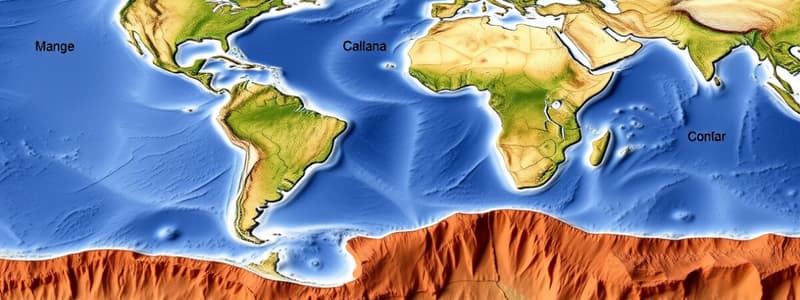Podcast
Questions and Answers
What distinguishes active margins from passive margins?
What distinguishes active margins from passive margins?
What geological processes are primarily associated with tectonic plate movement at active margins?
What geological processes are primarily associated with tectonic plate movement at active margins?
Which of the following best describes the composition of tectonic plates at passive margins?
Which of the following best describes the composition of tectonic plates at passive margins?
What causes the majority of geological activity at active margins?
What causes the majority of geological activity at active margins?
Signup and view all the answers
How thick can sediments in the transitional crust be at locations adjacent to continental margins?
How thick can sediments in the transitional crust be at locations adjacent to continental margins?
Signup and view all the answers
What is the feature called where ocean floor sediments are compressed between the subducting and overriding plates?
What is the feature called where ocean floor sediments are compressed between the subducting and overriding plates?
Signup and view all the answers
What geological feature can develop when fragments of continental material become attached to the accretionary wedge?
What geological feature can develop when fragments of continental material become attached to the accretionary wedge?
Signup and view all the answers
At what average depth do typical ocean basins lie, compared to trenches?
At what average depth do typical ocean basins lie, compared to trenches?
Signup and view all the answers
Which element is primarily pushed into the mantle wedge during the subduction process?
Which element is primarily pushed into the mantle wedge during the subduction process?
Signup and view all the answers
Which trench is known for reaching nearly 11 km in depth?
Which trench is known for reaching nearly 11 km in depth?
Signup and view all the answers
Study Notes
Tectonic Plates and Margins
- Tectonic plates consist of both oceanic and continental lithosphere.
- Passive margins occur where these plates connect without significant movement, exemplified by the eastern coastlines of North and South America.
- Active margins are characterized by interaction and movement between oceanic and continental plates, leading to geological activity like earthquakes and volcanism.
Plate Boundaries
- There are three main types of plate boundaries: convergent, divergent, and transform.
- Convergent boundaries often lead to subduction, where an oceanic plate dives beneath a continental plate, forming trenches.
- The Mariana Trench is the deepest subduction zone, reaching nearly 11 km below the ocean surface.
Accretionary Wedges and Terranes
- In subduction zones, sediments are compressed to form accretionary wedges, aiding in landmass formation.
- Accreted terranes can join the continental crust, expanding landmasses like those in California with fragments of microcontinents.
Subduction and Magma Formation
- Subduction zones create high-pressure zones where volatiles (like water and carbon dioxide) are released, lowering the melting point of the mantle wedge.
- Flux melting leads to magma formation, which can result in volcanic activity as the molten material rises to the Earth's surface.
Supercontinent Cycle
- Over geological time, continents converge to form supercontinents like Pangea, which existed around 335 million years ago.
- Plate movements contribute to the cycle of supercontinent formation and breakup, occurring approximately every 500 million years.
- Examples of ancient supercontinents include Rodinia, which existed 1.1 billion years ago and began breaking apart 800 million years ago.
Seismic Activity
- Subduction zones are known for generating large and deep earthquakes, including magnitude-9 events and tsunami threats.
- Stored energy between stuck tectonic plates can lead to significant seismic events when released.
Geological Features
- Foreland basins form near mountain belts due to the weight of mountains, resulting in depressions in the lithosphere.
- The Persian Gulf is an example of a foreland basin created by the nearby Zagros Mountains.
- Rare occurrences of obduction can trap portions of continental plates beneath oceanic plates during tectonic interactions.
Studying That Suits You
Use AI to generate personalized quizzes and flashcards to suit your learning preferences.
Related Documents
Description
Explore the characteristics and compositions of tectonic plates in this quiz. Learn about the passive margins connecting oceanic and continental lithosphere, with a focus on North and South America's features. Perfect for students of Earth sciences!




